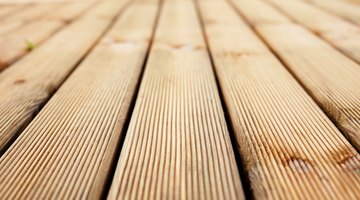Safe Ways to Shore Up a Deck
Decks with sagging boards, splintering or cracking support posts and loose concrete footings all require immediate attention and repair. Using a safe way to shore up a leaning or damaged deck can prevent serious injury or damage to your home.

Some of these methods can provide a permanent fix, while others should only be used as temporary measures until more thorough repairs can be made.
Use a Strong Fastener
Decks attached to the exterior of your home with nails, no matter how long they are, will slowly pull away from the wall and the risk of deck collapse will rise every year, says the North American Deck and Railing Association. If your deck is beginning to lean or pull away from where it is fastened to your home, the safest way to shore it up is to install appropriately sized bolts. The current fasteners do not have to be removed, but the new bolts should be added around the original fasteners. Other weight-bearing parts of the structure, such as the joists and support posts, should be augmented with bolts if they begin to detach from the deck.
Replace the Concrete Footings
Cracks and damage to the concrete footings allow the deck's support posts to shift, leading to a leaning or sagging deck. The Home Addition Plus website states that once a concrete footer is badly damaged by frost heaving or other issues, it should be removed and replaced. Pouring more concrete on top of the footer is not a safe way to shore up your deck because the cracks will quickly spread to the new material. The deck must be jacked up so the old concrete can be broken out with a sledge hammer before fresh concrete is poured in.
Jacking and Shimming
If your deck's foundation is made from blocks that sit on the ground instead of posts and poured concrete, it may be sagging and shifting due to instability below the foundation. Decks that are still intact and stable can be repaired with shims, according to the Canadian Home Workshop. You must use a house jack to lift each sagging or shifting area of the deck, then install pressure-treated wood boards between the deck and the foundation blocks. Getting your deck even using these method may take multiple adjustments. Although this is a safe way to shore up a sagging deck, it is not a permanent solution, and the deck will continue to shift until you replace the foundation blocks.
Shore the Joists
Rotting and splintering deck joists can cause serious injury to a guest if a section of the deck suddenly drops out from below them. Shoring up a damaged joist is only safe if the rot is limited and the other joists are in good condition, says DIY Advice. Support the joist with a piece of 2-by-4 inch lumber, and install lumber splints on both sides of the rotten or cracked section of the joist to secure it. The same lumber should be used for the splint that was used for the original joist.
References
Writer Bio
Jessica Kolifrath is a competent copywriter who has been writing professionally since 2008. She is based in the Atlanta area but travels around the Southeastern United States regularly. She currently holds an associate degree in psychology and is pursuing a bachelor's degree in the field.
Photo Credits
- Deck de madeira image by CarlosNeto from Fotolia.com
- Deck de madeira image by CarlosNeto from Fotolia.com
More Articles



